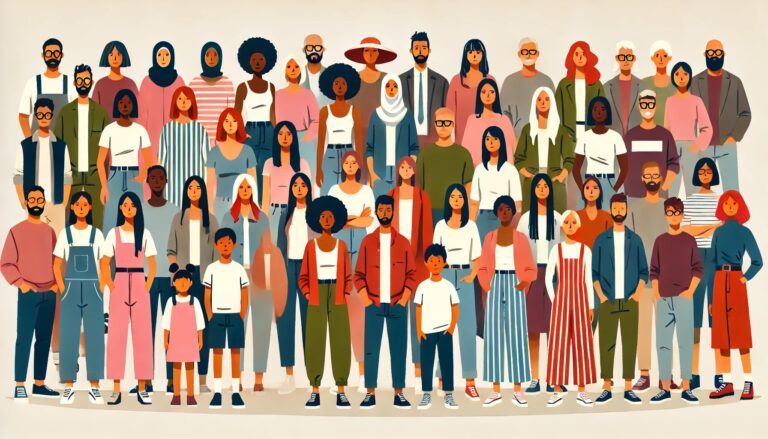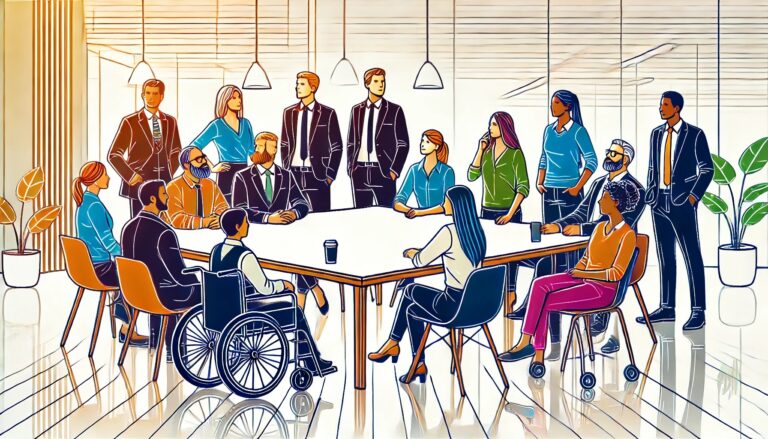
How To Use Inclusive Language Effectively?
How we communicate profoundly impacts our view of the world and, at the same time, our ability to foster inclusive, respectful, and supportive communities. Inclusive language is an essential component of communication, and it’s designed to avoid expressions or words that might be considered exclusionary or discriminatory toward particular groups of people, regardless of their location, gender, social status, education, etc.
This approach to language is not about policing words but about being mindful of their impact on promoting equality, diversity, and a sense of belonging among all individuals.
By consciously choosing words that welcome everyone, we can break down barriers of misunderstanding and prejudice.
But how do we incorporate and use inclusive language in our daily interactions, whether at the workplace, in online communities, in the recruiting process, or in our writing? This guide aims to give you some helpful advice on integrating language consciousness in your writing.
Understand the Basics of Inclusive Language

Inclusive language aims to avoid words and phrases that exclude certain groups of people, intentionally or not; it should not be seen as a way to avoid using specific terms and expressions but as a way to become more sensitive and mindful in our daily communication.
We can contribute to change by selecting words free from biases, stereotypes, or assumptions that could alienate or harm others based on their identity, background, or experiences.
Understanding the basic principles of inclusive language is the first step toward more thoughtful and respectful communication.
At its core, inclusive language acknowledges and respects all people’s experiences and identities. It involves being aware of language’s impact and making conscious choices to speak and write in ways that respect and affirm everyone’s humanity. Key concepts include:
- Gender neutrality: Using language that does not assume gender, including all gender identities.
- Cultural sensitivity: Choosing words that respect all cultures and avoiding phrases rooted in colonialism, racism, or cultural appropriation.
- Accessibility: Employing clear and straightforward language that can be understood by people with diverse abilities, including those with cognitive or learning disabilities.
- Avoidance of stereotypes: Avoid language that reinforces stereotypes or biases related to race, ethnicity, gender, age, sexual orientation, disability, or socio-economic status.
Examples of Non-Inclusive vs. Inclusive Language
Understanding the difference between non-inclusive and inclusive language can often be best illustrated through examples:
Gender-Neutral vs Gender-Specific Pronouns:
This example shows how gender-neutral pronouns like “their” can replace gender-specific pronouns like “his” to avoid assuming gender.
| Non-Inclusive | Inclusive |
| Each student must submit his assignment by Monday | Each student must submit their assignment by Monday |
Gender Bias:
Here, “chairperson” is used instead of “chairman” to avoid gender bias and to include all genders in leadership roles.
| Non-Inclusive | Inclusive |
| The chairman welcomed the guests | The chairperson welcomed the guests. |
Person-First Language:
This shift to person-first language emphasizes the person, not the disability, promoting respect and dignity.
| Non-Inclusive | Inclusive |
| The disabled person | The person with a disability |
Ableism:
Replacing ableist language that can trivialize mental health issues with more neutral terms shows sensitivity to mental health.
| Non-Inclusive | Inclusive |
| That’s crazy! | That’s surprising! |
Recognize and Avoid Gender-Biased Language
Using gender-neutral terms is a fundamental aspect of inclusive language, essential for creating an environment that respects and acknowledges all gender identities. Gender-biased language, often rooted in societal norms and stereotypes, can unintentionally exclude or marginalize individuals who do not identify within the traditional gender binary of male and female. Recognizing and avoiding gender-biased language is not just about being politically correct; it’s about fostering a culture of respect, equality, and understanding.
Importance of Using Gender-Neutral Terms
Gender-neutral language is crucial because it:
- Promotes equality: By avoiding assumptions about roles or characteristics based on gender, gender-neutral language treats all individuals as equals, irrespective of their gender identity.
- Increases accuracy: Gender-neutral terms are more precise when referring to groups or individuals whose gender is unknown or when the information is irrelevant to the context.
- Encourages inclusivity: Using gender-neutral language acknowledges the spectrum of gender identities and creates a more welcoming space for people of all genders to feel seen and respected.
Strategies for Avoiding Assumptions About Gender Roles or Identities
- Use gender-neutral pronouns and titles: Replace gender-specific pronouns (“he/she”) with “they” when referring to someone whose gender is unknown or to encompass all gender identities. Similarly, use gender-neutral titles like “firefighter” instead of “fireman” and “police officer” instead of “policeman.”
- Employ inclusive language in job titles and roles: Avoid job titles that inherently suggest a gender, opting for neutral alternatives that do not assume gender. For example, use “salesperson” instead of “salesman” and “chairperson” instead of “chairman.”
- Reframe sentences to remove the need for gendered pronouns: If possible, restructure sentences to eliminate the necessity for gendered pronouns. For instance, “Each participant must bring their own laptop” can be changed to “Participants must bring a laptop.”
- Be mindful of gender assumptions in everyday language: Challenge stereotypes and assumptions embedded in phrases like “manpower,” “man-made,” or expressions that assume roles based on gender, such as “nurse” implying a woman or “engineer” implying a man. Use neutral alternatives like “workforce,” “synthetic,” or simply state the profession without implying gender.
- Ask for and use people’s preferred pronouns: When known, always use an individual’s preferred pronouns. If unsure, politely ask or use their name until you know their preference.
Be Mindful of Cultural Sensitivity
Cultural sensitivity in language is about recognizing and respecting the vast diversity of cultures, ethnicities, and nationalities and their impact on communication. It involves using respectful and considerate language about cultural differences and avoiding terms or expressions that might be offensive or derogatory. Being culturally sensitive in our communication fosters mutual respect and enriches our interactions by allowing for a deeper understanding of diverse perspectives.
How to Respect Cultural Diversity Through Language
- Educate Yourself: Make an effort to learn about the cultures and ethnicities of the people you interact with. Understanding the basic cultural norms, values, and sensitivities can guide you in choosing the most respectful and appropriate language.
- Use Inclusive and Neutral Language: Employ terms that broadly encompass all cultures and avoid using language that centers on one culture as the norm. For example, instead of “Christmas party,” you might say “holiday party” to include celebrations from various cultures.
- Be Careful with Idioms and Slang: Phrases that are commonplace in one culture may be confusing or offensive in another. Unless you are sure they will be understood and appreciated, it’s best to use clear and straightforward language.
- Ask When Unsure: If you’re unsure how to refer to someone’s cultural or ethnic background, politely ask them or use the terms they prefer. People usually appreciate the effort to respect their identity.
- Avoid Cultural Stereotypes: Refrain from making generalizations about cultures or ethnicities. Stereotypes can be harmful and offensive, even if unintentionally so. Focus on the individual and avoid assuming all culture members share the same beliefs or behaviors.
Avoiding Stereotypes and Cultural Appropriation
- Recognize and Challenge Stereotypes: Be aware of the stereotypes you might hold, even unconsciously, and actively work to challenge and overcome them. Avoid language that reinforces stereotypes or reduces a culture to simplistic traits.
- Avoid Cultural Appropriation: Be mindful of using words, phrases, or references that may constitute cultural appropriation—a practice where elements of a culture are taken out of context, especially by dominant cultures without permission. Always show respect for the origins and significance of cultural expressions.
- Seek to Understand, Not to Exoticize: Approach cultural differences with curiosity and respect, rather than exoticizing or sensationalizing them. Use language that appreciates and values diversity without othering or marginalizing.
- Promote Equity and Representation: Use your communication to uplift and give voice to underrepresented cultures, representing them accurately and respectfully. Avoid tokenism and ensure that diverse voices are genuinely heard and acknowledged.
Being mindful of cultural sensitivity in language is not just about avoiding offense; it’s about actively contributing to a more inclusive, respectful, and understanding global community. By embracing the diversity of cultures and expressing this respect through our language, we pave the way for richer, more meaningful interactions and relationships.
Practical Steps to Implement Inclusive Language
Embracing inclusive language is a journey of continuous learning and adaptation. It requires a conscious effort to shift from ingrained linguistic habits to more mindful, respectful forms of communication. Implementing inclusive language in our daily lives makes our interactions more welcoming and models a commitment to diversity and respect for all individuals. Below are practical steps and daily practices to help cultivate a habit of using inclusive language, along with tips on addressing and correcting mistakes gracefully.
Daily Practices to Cultivate a Habit of Using Inclusive Language
- Self-education: Regularly educate yourself on inclusive language practices. Stay updated with the evolving guidelines and recommendations from reputable sources focused on diversity and inclusion.
- Use inclusive language tools and checklists: Review your communication using resources such as inclusive language guides or checklists. Tools like gender-neutral pronoun guides or cultural sensitivity checklists can be beneficial.
- Reflect on your language use: After conversations, take time to reflect on the language you used. Consider if there were instances where you could have used more inclusive language and think about how you can improve in the future.
- Practice mindfulness in written communication: Review your language for inclusivity before sending emails or publishing content. Editing tools and plugins designed to highlight non-inclusive language can be beneficial.
- Engage in conversations about inclusivity: Talk about the importance of inclusive language with friends, family, and colleagues. Sharing insights and learning from these discussions can further reinforce your commitment to inclusivity.
Correcting Mistakes Gracefully
- Acknowledge the mistake: If you catch yourself or are corrected for using non-inclusive language, acknowledge it promptly. A simple acknowledgment can go a long way in demonstrating your commitment to inclusivity.
- Apologize if necessary: If your language has unintentionally offended or excluded someone, offer a sincere apology without making excuses. This shows respect for the individual’s feelings and your willingness to learn.
- Learn from the mistake: Use the mistake as a learning opportunity. Research why the language was non-inclusive and what alternatives you could use in the future.
- Correct others with kindness and respect: If you’re in a position to correct someone else, do so gently and privately if possible. Frame the correction as a learning opportunity rather than a reprimand. For example, you might say, “I’ve learned recently that ‘X’ is a more inclusive way to say ‘Y’. I thought you might like to know too.”
- Commit to change: After correcting a mistake, make a mental or written note to avoid repeating it. Continuously working on improving your inclusive language practices is key to making lasting changes in how you communicate.
Implementing inclusive language is a proactive step towards creating more equitable and respectful environments. By incorporating these practical steps into our daily routines, we can all contribute to a culture that values and celebrates diversity in all its forms.








